Taxation Law Assignment: Tax Implications for Sophie, Kate, and Joe
VerifiedAdded on 2022/12/08
|16
|4228
|202
Homework Assignment
AI Summary
This assignment solution analyzes the taxation consequences for Sophie Jones, Kate, and Joe based on a provided scenario involving a faulty laser machine and subsequent legal proceedings. The solution addresses several key issues, including the tax treatment of lump-sum damages for reputation loss, compensation for income loss, and reimbursement of legal fees for Sophie. For Kate, the solution examines the taxation of compensation for pain and suffering, medical costs, and interest earned on compensation. Additionally, the solution considers the tax implications for Joe, focusing on capital gains tax and CGT assets. The analysis references relevant legal principles and case law to support the conclusions, providing a comprehensive understanding of the taxation issues presented in the case study.
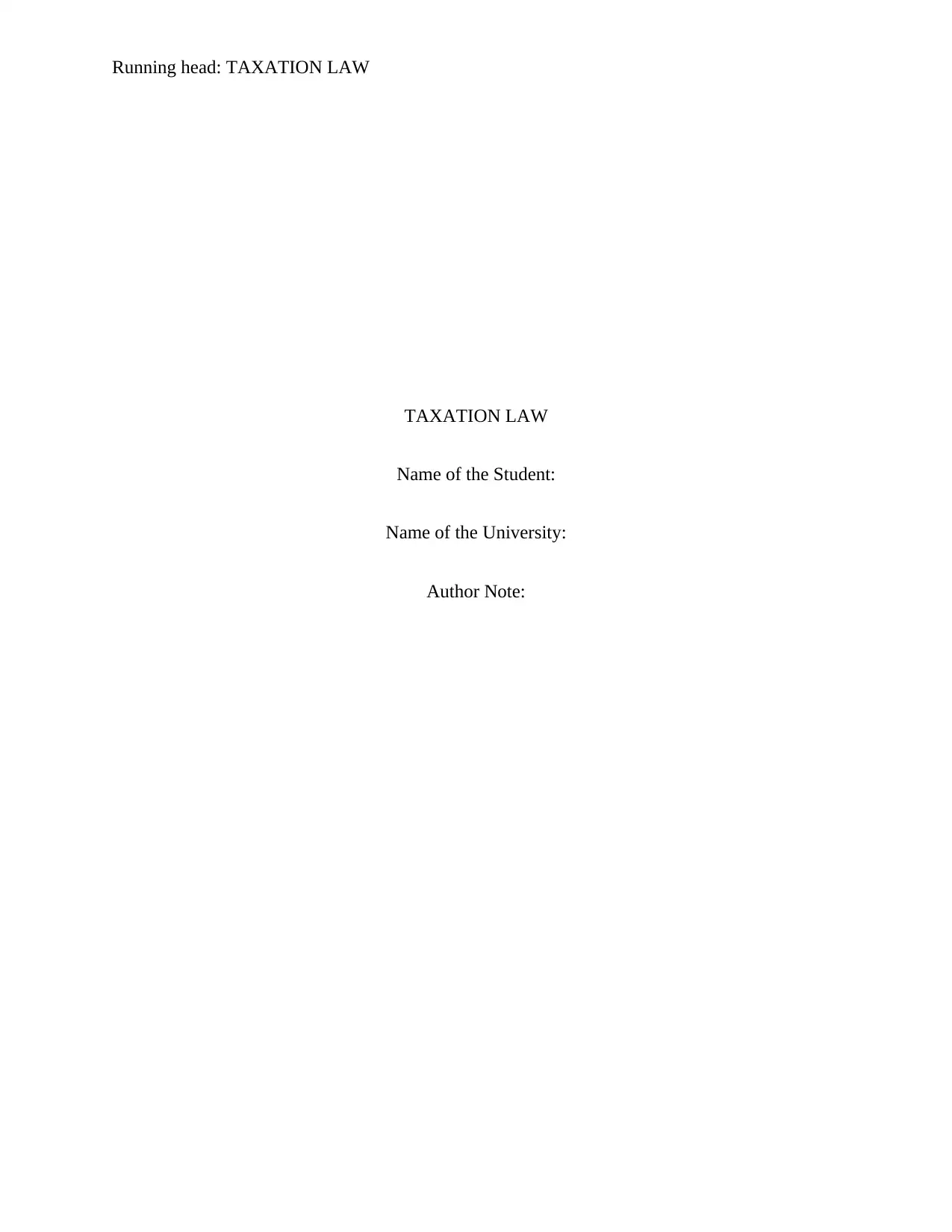
Running head: TAXATION LAW
TAXATION LAW
Name of the Student:
Name of the University:
Author Note:
TAXATION LAW
Name of the Student:
Name of the University:
Author Note:
Paraphrase This Document
Need a fresh take? Get an instant paraphrase of this document with our AI Paraphraser

1TAXATION LAW
Answer 1:
For Sophie:
Issue No. 1:
The concerned issue here is the taxation consequence of lump sum amount of damages
for the potential reputation loss.
Rules:
A perusal of the principle held in the decision of Whitaker v FC of T 98 ATC 428
provides that any receipt that has been incurred by means of compensation due a personal type of
injury will be considered as capital gain and hence will come under the application of the capital
gain taxation.
Moreover, the decision given in the FC of T v Sydney Refractive Surgery Centre Pty Ltd
2008 ATC ¶20-081 reveals that any sum of money which is being received by an individual
taxpayer for loss of his/her reputation will be exposed to taxation as the capital asset gain. The
reason behind this is that when organization losses its reputation, its capability of incurring profit
will be reduced.
Application:
In the present case, it is observed that a newly launched laser when applied on Kate, the
1st client by using a machine bought from an organization called racPro Pty Ltd by Sophie, Kate
got severe blisters that caused permanent scars. The lump sum money of about 100, 000 $ was
received by Sophie for potential reputation loss. This is required to be treated as capital gain
Answer 1:
For Sophie:
Issue No. 1:
The concerned issue here is the taxation consequence of lump sum amount of damages
for the potential reputation loss.
Rules:
A perusal of the principle held in the decision of Whitaker v FC of T 98 ATC 428
provides that any receipt that has been incurred by means of compensation due a personal type of
injury will be considered as capital gain and hence will come under the application of the capital
gain taxation.
Moreover, the decision given in the FC of T v Sydney Refractive Surgery Centre Pty Ltd
2008 ATC ¶20-081 reveals that any sum of money which is being received by an individual
taxpayer for loss of his/her reputation will be exposed to taxation as the capital asset gain. The
reason behind this is that when organization losses its reputation, its capability of incurring profit
will be reduced.
Application:
In the present case, it is observed that a newly launched laser when applied on Kate, the
1st client by using a machine bought from an organization called racPro Pty Ltd by Sophie, Kate
got severe blisters that caused permanent scars. The lump sum money of about 100, 000 $ was
received by Sophie for potential reputation loss. This is required to be treated as capital gain
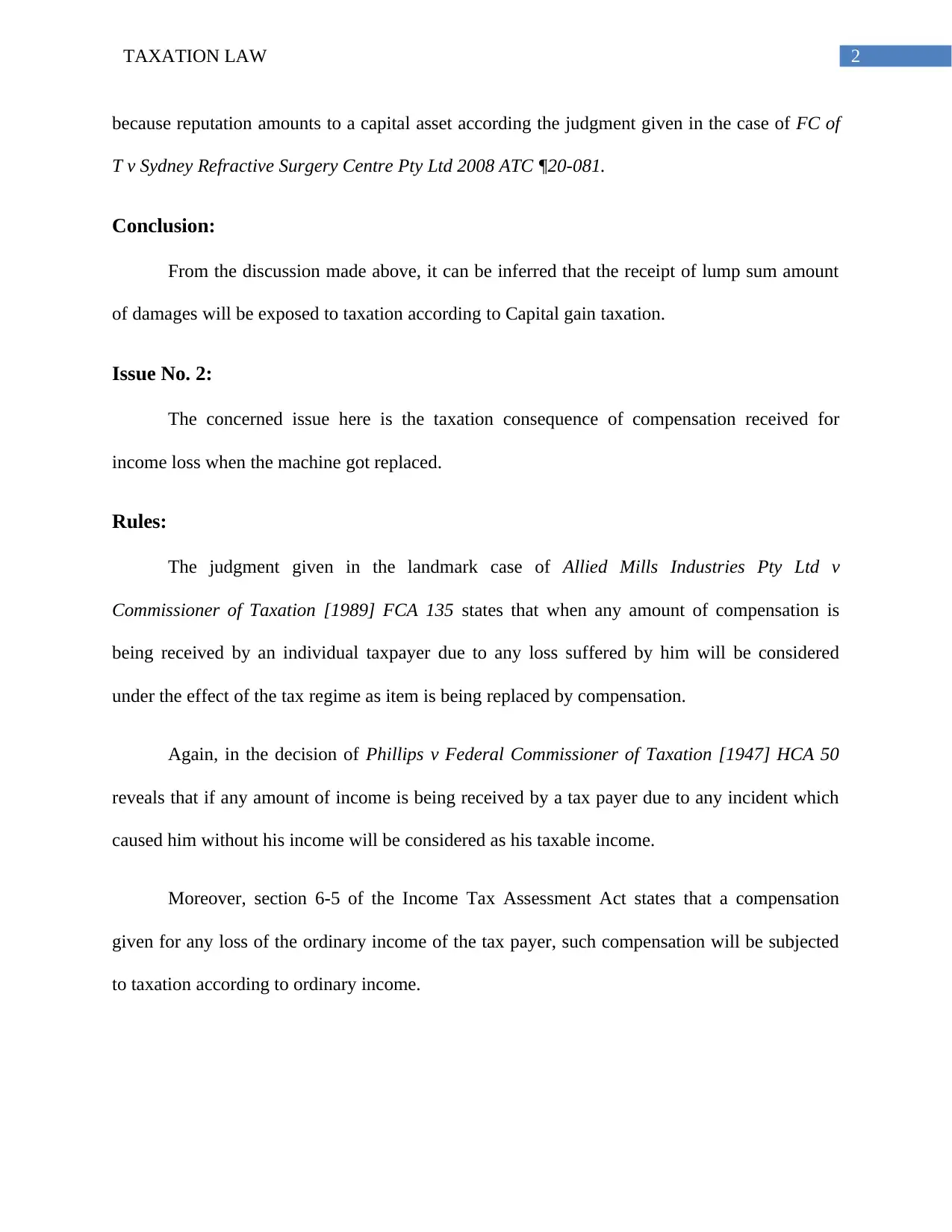
2TAXATION LAW
because reputation amounts to a capital asset according the judgment given in the case of FC of
T v Sydney Refractive Surgery Centre Pty Ltd 2008 ATC ¶20-081.
Conclusion:
From the discussion made above, it can be inferred that the receipt of lump sum amount
of damages will be exposed to taxation according to Capital gain taxation.
Issue No. 2:
The concerned issue here is the taxation consequence of compensation received for
income loss when the machine got replaced.
Rules:
The judgment given in the landmark case of Allied Mills Industries Pty Ltd v
Commissioner of Taxation [1989] FCA 135 states that when any amount of compensation is
being received by an individual taxpayer due to any loss suffered by him will be considered
under the effect of the tax regime as item is being replaced by compensation.
Again, in the decision of Phillips v Federal Commissioner of Taxation [1947] HCA 50
reveals that if any amount of income is being received by a tax payer due to any incident which
caused him without his income will be considered as his taxable income.
Moreover, section 6-5 of the Income Tax Assessment Act states that a compensation
given for any loss of the ordinary income of the tax payer, such compensation will be subjected
to taxation according to ordinary income.
because reputation amounts to a capital asset according the judgment given in the case of FC of
T v Sydney Refractive Surgery Centre Pty Ltd 2008 ATC ¶20-081.
Conclusion:
From the discussion made above, it can be inferred that the receipt of lump sum amount
of damages will be exposed to taxation according to Capital gain taxation.
Issue No. 2:
The concerned issue here is the taxation consequence of compensation received for
income loss when the machine got replaced.
Rules:
The judgment given in the landmark case of Allied Mills Industries Pty Ltd v
Commissioner of Taxation [1989] FCA 135 states that when any amount of compensation is
being received by an individual taxpayer due to any loss suffered by him will be considered
under the effect of the tax regime as item is being replaced by compensation.
Again, in the decision of Phillips v Federal Commissioner of Taxation [1947] HCA 50
reveals that if any amount of income is being received by a tax payer due to any incident which
caused him without his income will be considered as his taxable income.
Moreover, section 6-5 of the Income Tax Assessment Act states that a compensation
given for any loss of the ordinary income of the tax payer, such compensation will be subjected
to taxation according to ordinary income.
⊘ This is a preview!⊘
Do you want full access?
Subscribe today to unlock all pages.

Trusted by 1+ million students worldwide

3TAXATION LAW
Application:
In the present case, the sum of 20000 $ is being received by Sophie Jones as
compensation in lieu of her income loss incurred by him during the period in which the machine
was taken for replacement. During that period, if the machine was not taken for replacement,
Sophie could use it and earn income out of it and such income will be her assessable income. She
suffered from income loss due to the replacement. Thus compensation for this will amount to an
income and will be considered as ordinary income for purpose of taxation.
Conclusion:
Thus the taxation consequence of compensation received for income loss when the
machine got replaced will amount to her ordinary income.
Issue No. 3:
The concerned issue here is the taxation consequence for reimbursing of the legal fees.
Rule:
It has been observed in the leading case of HR Sinclair & Son Pty Ltd v FC of T (1966)
114 CLR 537b that any amount of money received as reimbursement of any expenditure which is
normally allowed as deduction will be regarded as capital gain and hence will amount to
assessable income as the statutory income.
Moreover, any legal fee is to be considered as a deduction allowable from the taxation
point of view. It was construed in the decision given in FC of T v Rowe 97 ATC 4317. Such fee
when reimbursed will amount to a compensation for the expense which will be generally
considered to be an allowable deduction and thus it is to be considered as capital gain.
Application:
In the present case, the sum of 20000 $ is being received by Sophie Jones as
compensation in lieu of her income loss incurred by him during the period in which the machine
was taken for replacement. During that period, if the machine was not taken for replacement,
Sophie could use it and earn income out of it and such income will be her assessable income. She
suffered from income loss due to the replacement. Thus compensation for this will amount to an
income and will be considered as ordinary income for purpose of taxation.
Conclusion:
Thus the taxation consequence of compensation received for income loss when the
machine got replaced will amount to her ordinary income.
Issue No. 3:
The concerned issue here is the taxation consequence for reimbursing of the legal fees.
Rule:
It has been observed in the leading case of HR Sinclair & Son Pty Ltd v FC of T (1966)
114 CLR 537b that any amount of money received as reimbursement of any expenditure which is
normally allowed as deduction will be regarded as capital gain and hence will amount to
assessable income as the statutory income.
Moreover, any legal fee is to be considered as a deduction allowable from the taxation
point of view. It was construed in the decision given in FC of T v Rowe 97 ATC 4317. Such fee
when reimbursed will amount to a compensation for the expense which will be generally
considered to be an allowable deduction and thus it is to be considered as capital gain.
Paraphrase This Document
Need a fresh take? Get an instant paraphrase of this document with our AI Paraphraser
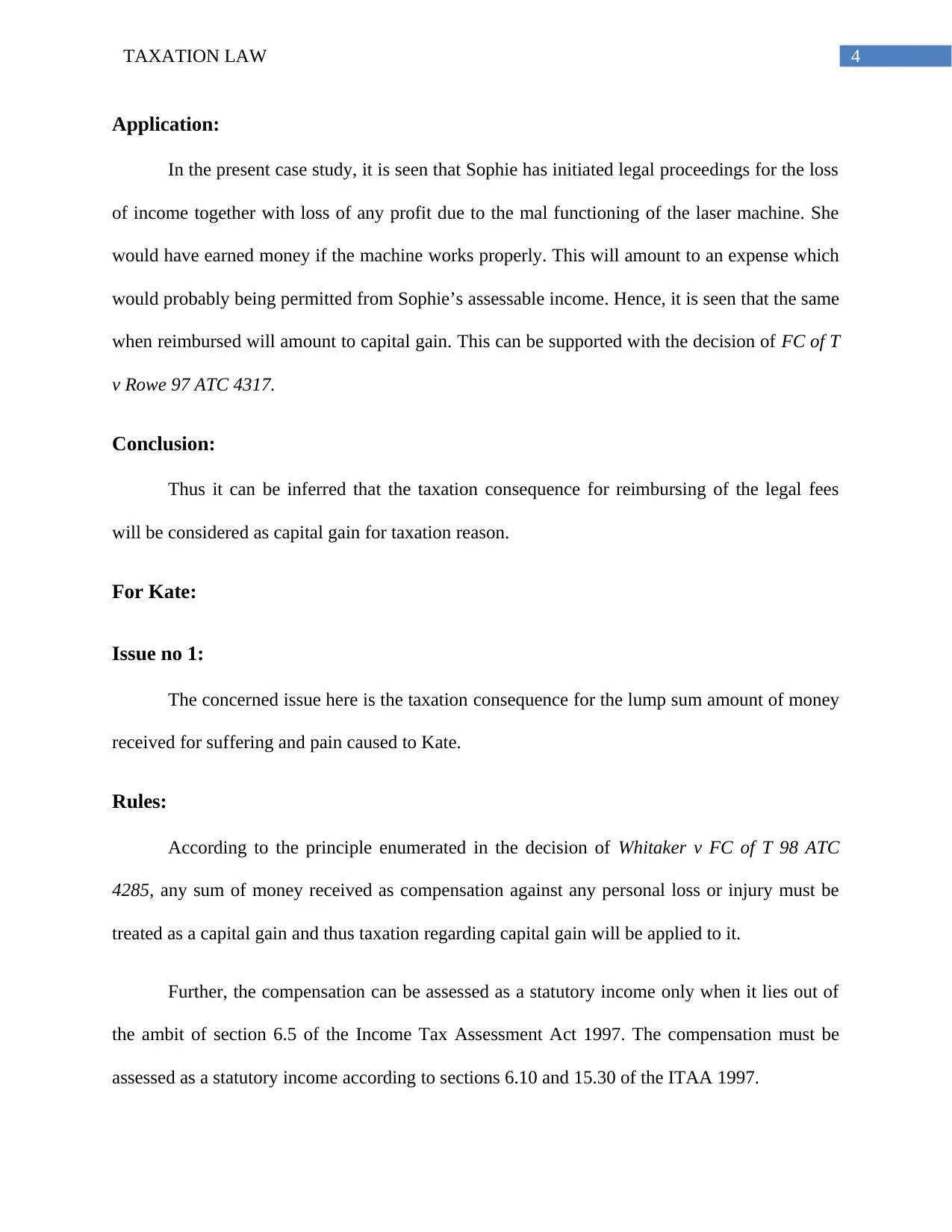
4TAXATION LAW
Application:
In the present case study, it is seen that Sophie has initiated legal proceedings for the loss
of income together with loss of any profit due to the mal functioning of the laser machine. She
would have earned money if the machine works properly. This will amount to an expense which
would probably being permitted from Sophie’s assessable income. Hence, it is seen that the same
when reimbursed will amount to capital gain. This can be supported with the decision of FC of T
v Rowe 97 ATC 4317.
Conclusion:
Thus it can be inferred that the taxation consequence for reimbursing of the legal fees
will be considered as capital gain for taxation reason.
For Kate:
Issue no 1:
The concerned issue here is the taxation consequence for the lump sum amount of money
received for suffering and pain caused to Kate.
Rules:
According to the principle enumerated in the decision of Whitaker v FC of T 98 ATC
4285, any sum of money received as compensation against any personal loss or injury must be
treated as a capital gain and thus taxation regarding capital gain will be applied to it.
Further, the compensation can be assessed as a statutory income only when it lies out of
the ambit of section 6.5 of the Income Tax Assessment Act 1997. The compensation must be
assessed as a statutory income according to sections 6.10 and 15.30 of the ITAA 1997.
Application:
In the present case study, it is seen that Sophie has initiated legal proceedings for the loss
of income together with loss of any profit due to the mal functioning of the laser machine. She
would have earned money if the machine works properly. This will amount to an expense which
would probably being permitted from Sophie’s assessable income. Hence, it is seen that the same
when reimbursed will amount to capital gain. This can be supported with the decision of FC of T
v Rowe 97 ATC 4317.
Conclusion:
Thus it can be inferred that the taxation consequence for reimbursing of the legal fees
will be considered as capital gain for taxation reason.
For Kate:
Issue no 1:
The concerned issue here is the taxation consequence for the lump sum amount of money
received for suffering and pain caused to Kate.
Rules:
According to the principle enumerated in the decision of Whitaker v FC of T 98 ATC
4285, any sum of money received as compensation against any personal loss or injury must be
treated as a capital gain and thus taxation regarding capital gain will be applied to it.
Further, the compensation can be assessed as a statutory income only when it lies out of
the ambit of section 6.5 of the Income Tax Assessment Act 1997. The compensation must be
assessed as a statutory income according to sections 6.10 and 15.30 of the ITAA 1997.
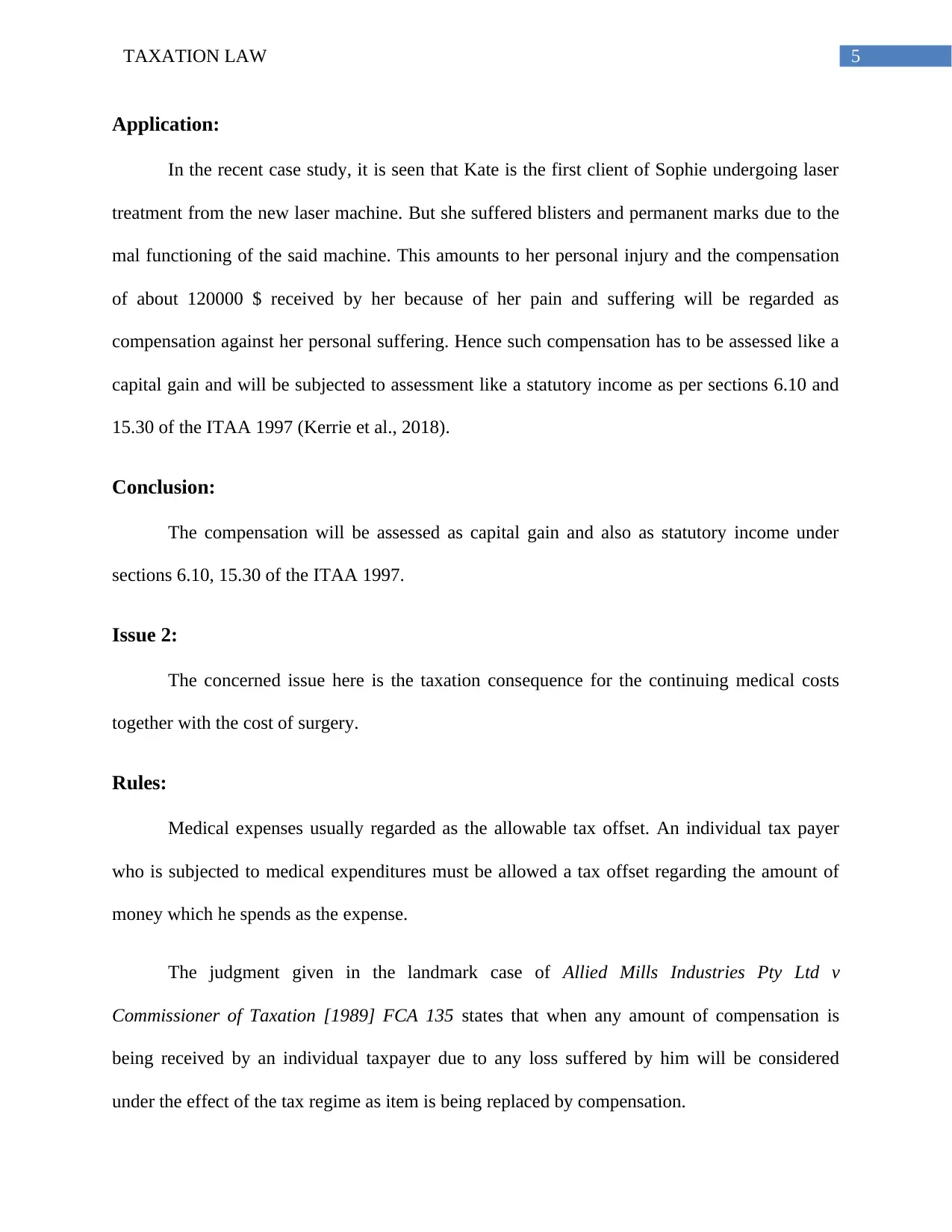
5TAXATION LAW
Application:
In the recent case study, it is seen that Kate is the first client of Sophie undergoing laser
treatment from the new laser machine. But she suffered blisters and permanent marks due to the
mal functioning of the said machine. This amounts to her personal injury and the compensation
of about 120000 $ received by her because of her pain and suffering will be regarded as
compensation against her personal suffering. Hence such compensation has to be assessed like a
capital gain and will be subjected to assessment like a statutory income as per sections 6.10 and
15.30 of the ITAA 1997 (Kerrie et al., 2018).
Conclusion:
The compensation will be assessed as capital gain and also as statutory income under
sections 6.10, 15.30 of the ITAA 1997.
Issue 2:
The concerned issue here is the taxation consequence for the continuing medical costs
together with the cost of surgery.
Rules:
Medical expenses usually regarded as the allowable tax offset. An individual tax payer
who is subjected to medical expenditures must be allowed a tax offset regarding the amount of
money which he spends as the expense.
The judgment given in the landmark case of Allied Mills Industries Pty Ltd v
Commissioner of Taxation [1989] FCA 135 states that when any amount of compensation is
being received by an individual taxpayer due to any loss suffered by him will be considered
under the effect of the tax regime as item is being replaced by compensation.
Application:
In the recent case study, it is seen that Kate is the first client of Sophie undergoing laser
treatment from the new laser machine. But she suffered blisters and permanent marks due to the
mal functioning of the said machine. This amounts to her personal injury and the compensation
of about 120000 $ received by her because of her pain and suffering will be regarded as
compensation against her personal suffering. Hence such compensation has to be assessed like a
capital gain and will be subjected to assessment like a statutory income as per sections 6.10 and
15.30 of the ITAA 1997 (Kerrie et al., 2018).
Conclusion:
The compensation will be assessed as capital gain and also as statutory income under
sections 6.10, 15.30 of the ITAA 1997.
Issue 2:
The concerned issue here is the taxation consequence for the continuing medical costs
together with the cost of surgery.
Rules:
Medical expenses usually regarded as the allowable tax offset. An individual tax payer
who is subjected to medical expenditures must be allowed a tax offset regarding the amount of
money which he spends as the expense.
The judgment given in the landmark case of Allied Mills Industries Pty Ltd v
Commissioner of Taxation [1989] FCA 135 states that when any amount of compensation is
being received by an individual taxpayer due to any loss suffered by him will be considered
under the effect of the tax regime as item is being replaced by compensation.
⊘ This is a preview!⊘
Do you want full access?
Subscribe today to unlock all pages.

Trusted by 1+ million students worldwide

6TAXATION LAW
Thus the compensation is given with an objective for mitigating the expenditure of the
medical expense. The reimbursement or refund of the expenditure will cause reduction of the
expenses. Thus the refund will be deducted from the amount of tax offset which is being applied
to the tax payer’s taxable income in relation to the medical expense.
Application:
In the present case, the reimbursement of the medical expenditure which is continuing
will be considered as tax offset. Whatever has been received by Kate as refund or reimbursement
against the medical expenditure will be considered as reduction of the expense and thus it is
required to be deducted from the allowed tax offset.
Conclusion:
The reimbursement for the continuing medical costs together with the cost of surgery will
be considered as the tax offset for the expense deduction.
Issue 3:
The concerned issue here is the taxation consequence for the interest incurred on the
lump sum amount payment.
Rules:
According to the principle given in the decision of Federal Wharf Co Ltd v DFC of T
(1930) 44 CLR 24, the compensation which is received by an individual tax payer through
interest against any temporary loss incurred in relation to the utilization of money will be
considered as the income of capital nature.
Thus the compensation is given with an objective for mitigating the expenditure of the
medical expense. The reimbursement or refund of the expenditure will cause reduction of the
expenses. Thus the refund will be deducted from the amount of tax offset which is being applied
to the tax payer’s taxable income in relation to the medical expense.
Application:
In the present case, the reimbursement of the medical expenditure which is continuing
will be considered as tax offset. Whatever has been received by Kate as refund or reimbursement
against the medical expenditure will be considered as reduction of the expense and thus it is
required to be deducted from the allowed tax offset.
Conclusion:
The reimbursement for the continuing medical costs together with the cost of surgery will
be considered as the tax offset for the expense deduction.
Issue 3:
The concerned issue here is the taxation consequence for the interest incurred on the
lump sum amount payment.
Rules:
According to the principle given in the decision of Federal Wharf Co Ltd v DFC of T
(1930) 44 CLR 24, the compensation which is received by an individual tax payer through
interest against any temporary loss incurred in relation to the utilization of money will be
considered as the income of capital nature.
Paraphrase This Document
Need a fresh take? Get an instant paraphrase of this document with our AI Paraphraser
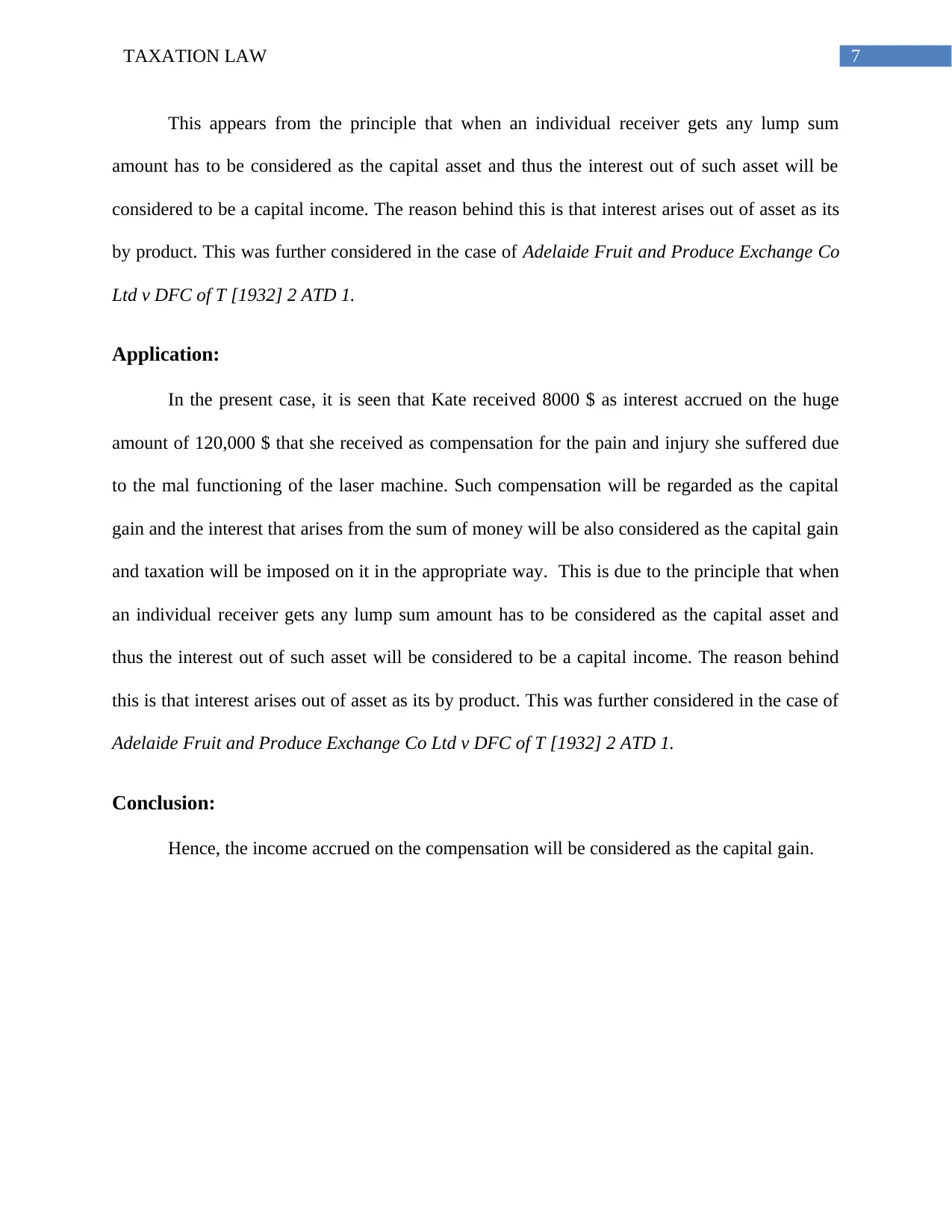
7TAXATION LAW
This appears from the principle that when an individual receiver gets any lump sum
amount has to be considered as the capital asset and thus the interest out of such asset will be
considered to be a capital income. The reason behind this is that interest arises out of asset as its
by product. This was further considered in the case of Adelaide Fruit and Produce Exchange Co
Ltd v DFC of T [1932] 2 ATD 1.
Application:
In the present case, it is seen that Kate received 8000 $ as interest accrued on the huge
amount of 120,000 $ that she received as compensation for the pain and injury she suffered due
to the mal functioning of the laser machine. Such compensation will be regarded as the capital
gain and the interest that arises from the sum of money will be also considered as the capital gain
and taxation will be imposed on it in the appropriate way. This is due to the principle that when
an individual receiver gets any lump sum amount has to be considered as the capital asset and
thus the interest out of such asset will be considered to be a capital income. The reason behind
this is that interest arises out of asset as its by product. This was further considered in the case of
Adelaide Fruit and Produce Exchange Co Ltd v DFC of T [1932] 2 ATD 1.
Conclusion:
Hence, the income accrued on the compensation will be considered as the capital gain.
This appears from the principle that when an individual receiver gets any lump sum
amount has to be considered as the capital asset and thus the interest out of such asset will be
considered to be a capital income. The reason behind this is that interest arises out of asset as its
by product. This was further considered in the case of Adelaide Fruit and Produce Exchange Co
Ltd v DFC of T [1932] 2 ATD 1.
Application:
In the present case, it is seen that Kate received 8000 $ as interest accrued on the huge
amount of 120,000 $ that she received as compensation for the pain and injury she suffered due
to the mal functioning of the laser machine. Such compensation will be regarded as the capital
gain and the interest that arises from the sum of money will be also considered as the capital gain
and taxation will be imposed on it in the appropriate way. This is due to the principle that when
an individual receiver gets any lump sum amount has to be considered as the capital asset and
thus the interest out of such asset will be considered to be a capital income. The reason behind
this is that interest arises out of asset as its by product. This was further considered in the case of
Adelaide Fruit and Produce Exchange Co Ltd v DFC of T [1932] 2 ATD 1.
Conclusion:
Hence, the income accrued on the compensation will be considered as the capital gain.
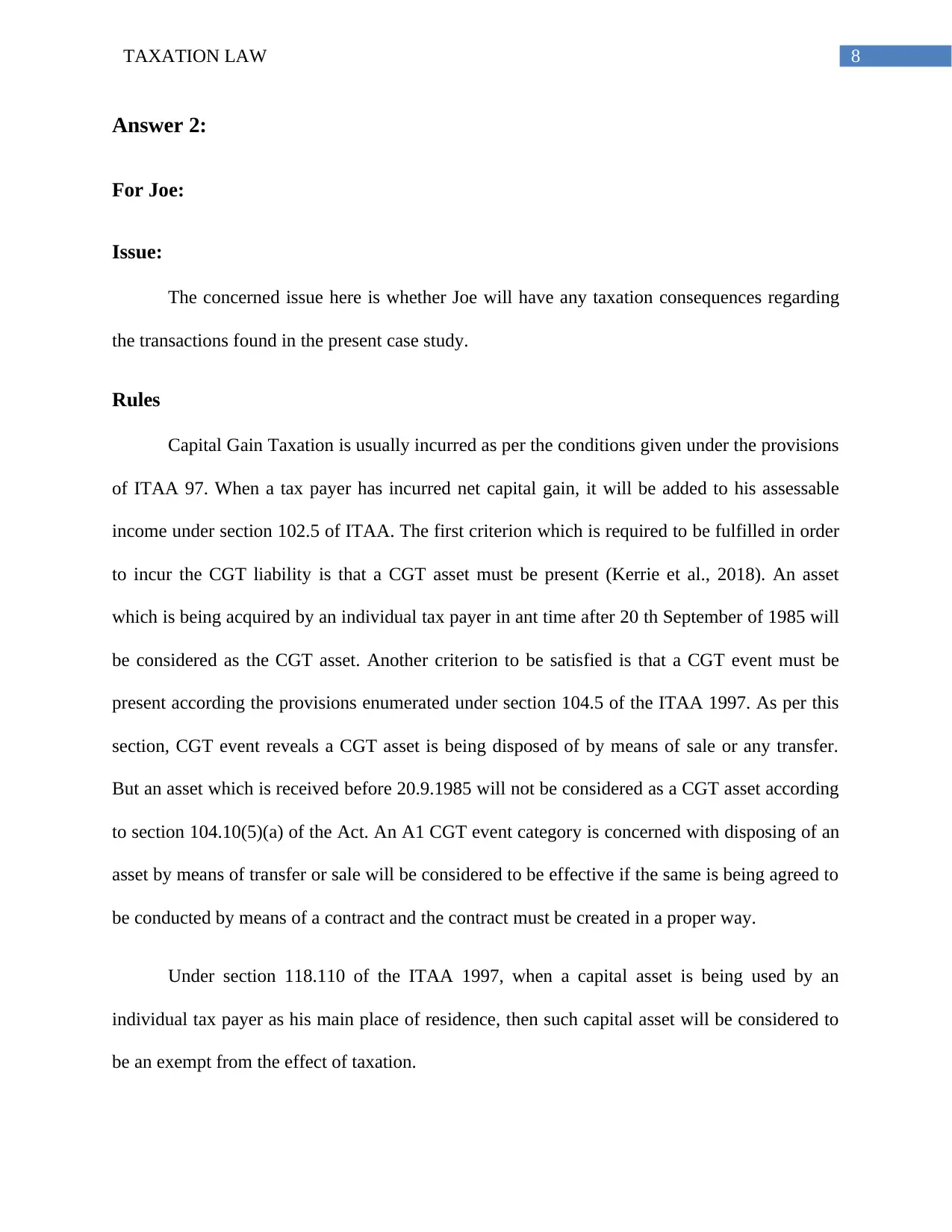
8TAXATION LAW
Answer 2:
For Joe:
Issue:
The concerned issue here is whether Joe will have any taxation consequences regarding
the transactions found in the present case study.
Rules
Capital Gain Taxation is usually incurred as per the conditions given under the provisions
of ITAA 97. When a tax payer has incurred net capital gain, it will be added to his assessable
income under section 102.5 of ITAA. The first criterion which is required to be fulfilled in order
to incur the CGT liability is that a CGT asset must be present (Kerrie et al., 2018). An asset
which is being acquired by an individual tax payer in ant time after 20 th September of 1985 will
be considered as the CGT asset. Another criterion to be satisfied is that a CGT event must be
present according the provisions enumerated under section 104.5 of the ITAA 1997. As per this
section, CGT event reveals a CGT asset is being disposed of by means of sale or any transfer.
But an asset which is received before 20.9.1985 will not be considered as a CGT asset according
to section 104.10(5)(a) of the Act. An A1 CGT event category is concerned with disposing of an
asset by means of transfer or sale will be considered to be effective if the same is being agreed to
be conducted by means of a contract and the contract must be created in a proper way.
Under section 118.110 of the ITAA 1997, when a capital asset is being used by an
individual tax payer as his main place of residence, then such capital asset will be considered to
be an exempt from the effect of taxation.
Answer 2:
For Joe:
Issue:
The concerned issue here is whether Joe will have any taxation consequences regarding
the transactions found in the present case study.
Rules
Capital Gain Taxation is usually incurred as per the conditions given under the provisions
of ITAA 97. When a tax payer has incurred net capital gain, it will be added to his assessable
income under section 102.5 of ITAA. The first criterion which is required to be fulfilled in order
to incur the CGT liability is that a CGT asset must be present (Kerrie et al., 2018). An asset
which is being acquired by an individual tax payer in ant time after 20 th September of 1985 will
be considered as the CGT asset. Another criterion to be satisfied is that a CGT event must be
present according the provisions enumerated under section 104.5 of the ITAA 1997. As per this
section, CGT event reveals a CGT asset is being disposed of by means of sale or any transfer.
But an asset which is received before 20.9.1985 will not be considered as a CGT asset according
to section 104.10(5)(a) of the Act. An A1 CGT event category is concerned with disposing of an
asset by means of transfer or sale will be considered to be effective if the same is being agreed to
be conducted by means of a contract and the contract must be created in a proper way.
Under section 118.110 of the ITAA 1997, when a capital asset is being used by an
individual tax payer as his main place of residence, then such capital asset will be considered to
be an exempt from the effect of taxation.
⊘ This is a preview!⊘
Do you want full access?
Subscribe today to unlock all pages.

Trusted by 1+ million students worldwide

9TAXATION LAW
According to section 118.195, it is provided that dwelling house resulting out of a
deceased person can be exempted when the estate is a pre-CGT asset of the deceased and further
such property was disposed within a period of 2 years after his death. For post CGT asset, the
rule is not same. Such exemption can be availed when the property concerned was the deceased
person’s main place of residence and not used for earning income.
Moreover, no tax can be paid at the time when the property is inherited because of death
as given u/s 128.10. Again, the cost base for the person who succeeds the asset in case the
deceased bought the house prior to 20.9.1985, then CB amounts to the market value for the
house when the death occurred as given under section 128.15(4).
Moreover according to the principles enumerated in the decision of the Greig v
Commissioner of Taxation [2018] FCA 1084 case, in case where some major alternatives are
being made to any piece of land with an objective to earn more returns from disposing the land
by means of sale will be regarded as the business venture. For this, there must be some business
aspect present in the activities involved in the arrangements that has resulted in the land disposal
which will be considered as a business and the proceeds out of it will be considered as an
ordinary income.
Application:
In the present case study, it is seen that that the original piece of land was acquired by
Bob in the month of January 1982. This showed that the land cannot be considered as capital
gain. However another tax payer Joe has got the land by means of inheritance on 23rd of May
2015. Thus for Joe, the land asset will come under the effect of the CGT asset since it was
inherited after the prescribed date as per section 128.10.
According to section 118.195, it is provided that dwelling house resulting out of a
deceased person can be exempted when the estate is a pre-CGT asset of the deceased and further
such property was disposed within a period of 2 years after his death. For post CGT asset, the
rule is not same. Such exemption can be availed when the property concerned was the deceased
person’s main place of residence and not used for earning income.
Moreover, no tax can be paid at the time when the property is inherited because of death
as given u/s 128.10. Again, the cost base for the person who succeeds the asset in case the
deceased bought the house prior to 20.9.1985, then CB amounts to the market value for the
house when the death occurred as given under section 128.15(4).
Moreover according to the principles enumerated in the decision of the Greig v
Commissioner of Taxation [2018] FCA 1084 case, in case where some major alternatives are
being made to any piece of land with an objective to earn more returns from disposing the land
by means of sale will be regarded as the business venture. For this, there must be some business
aspect present in the activities involved in the arrangements that has resulted in the land disposal
which will be considered as a business and the proceeds out of it will be considered as an
ordinary income.
Application:
In the present case study, it is seen that that the original piece of land was acquired by
Bob in the month of January 1982. This showed that the land cannot be considered as capital
gain. However another tax payer Joe has got the land by means of inheritance on 23rd of May
2015. Thus for Joe, the land asset will come under the effect of the CGT asset since it was
inherited after the prescribed date as per section 128.10.
Paraphrase This Document
Need a fresh take? Get an instant paraphrase of this document with our AI Paraphraser

10TAXATION LAW
But later on they made a sale of their house at 680,000 $. This amounts to a CGT asset
disposal under s 108.5 and a CGT event occurs as per s 104.10 A1. Here the event occurred
when the disposal agreement is signed ie, 28.05.2019 as provide under the McDonalds v FCT (1998)
and also u/s 104.10(3). Here the cost base for both is 560,000 $ according to section 128.15(4)
and thus CB equals to the market price of the house when the father died. The CP u/s 116.20
equals to the sum of money that they will be receiving by selling the house which is 680,000$. In
case they receive the selling price next year, CP will be same as the contract was affected on Fy
2018-2019.
Here CB= 560000. CP= 680000. Hence the CG= 680000-560000= 120000.
Again under section 115, asset acquired after 11.45 am of 21 September 1999 will be
assessed under discounted method. To apply this, the asset has to be held for minimum 12
months u/s 115.25 by an individual u/s 115.10. hence 50% discount is allowed. Net CG= 50% of
120000= 600000 $.
Here both Joe and Amy got 50 % share, thus they will get 50% CG each= 300000$. But
u/s 118.10, such CG will be not considered when the tax payer is an individual and using the
property as main residential place. However this is not applied when a property is inherited after
death of the owner. Moreover, u/s 118.195, a dwelling place resulting out of a deceased property
is exempted when the asset is a pre CGT asset of the deceased and the property is disposed
within 2 years from the death. But for post CGT asset rule differs. Such exemption can be
availed when the property concerned was the deceased person’s main place of residence and not
used for earning income.
But later on they made a sale of their house at 680,000 $. This amounts to a CGT asset
disposal under s 108.5 and a CGT event occurs as per s 104.10 A1. Here the event occurred
when the disposal agreement is signed ie, 28.05.2019 as provide under the McDonalds v FCT (1998)
and also u/s 104.10(3). Here the cost base for both is 560,000 $ according to section 128.15(4)
and thus CB equals to the market price of the house when the father died. The CP u/s 116.20
equals to the sum of money that they will be receiving by selling the house which is 680,000$. In
case they receive the selling price next year, CP will be same as the contract was affected on Fy
2018-2019.
Here CB= 560000. CP= 680000. Hence the CG= 680000-560000= 120000.
Again under section 115, asset acquired after 11.45 am of 21 September 1999 will be
assessed under discounted method. To apply this, the asset has to be held for minimum 12
months u/s 115.25 by an individual u/s 115.10. hence 50% discount is allowed. Net CG= 50% of
120000= 600000 $.
Here both Joe and Amy got 50 % share, thus they will get 50% CG each= 300000$. But
u/s 118.10, such CG will be not considered when the tax payer is an individual and using the
property as main residential place. However this is not applied when a property is inherited after
death of the owner. Moreover, u/s 118.195, a dwelling place resulting out of a deceased property
is exempted when the asset is a pre CGT asset of the deceased and the property is disposed
within 2 years from the death. But for post CGT asset rule differs. Such exemption can be
availed when the property concerned was the deceased person’s main place of residence and not
used for earning income.
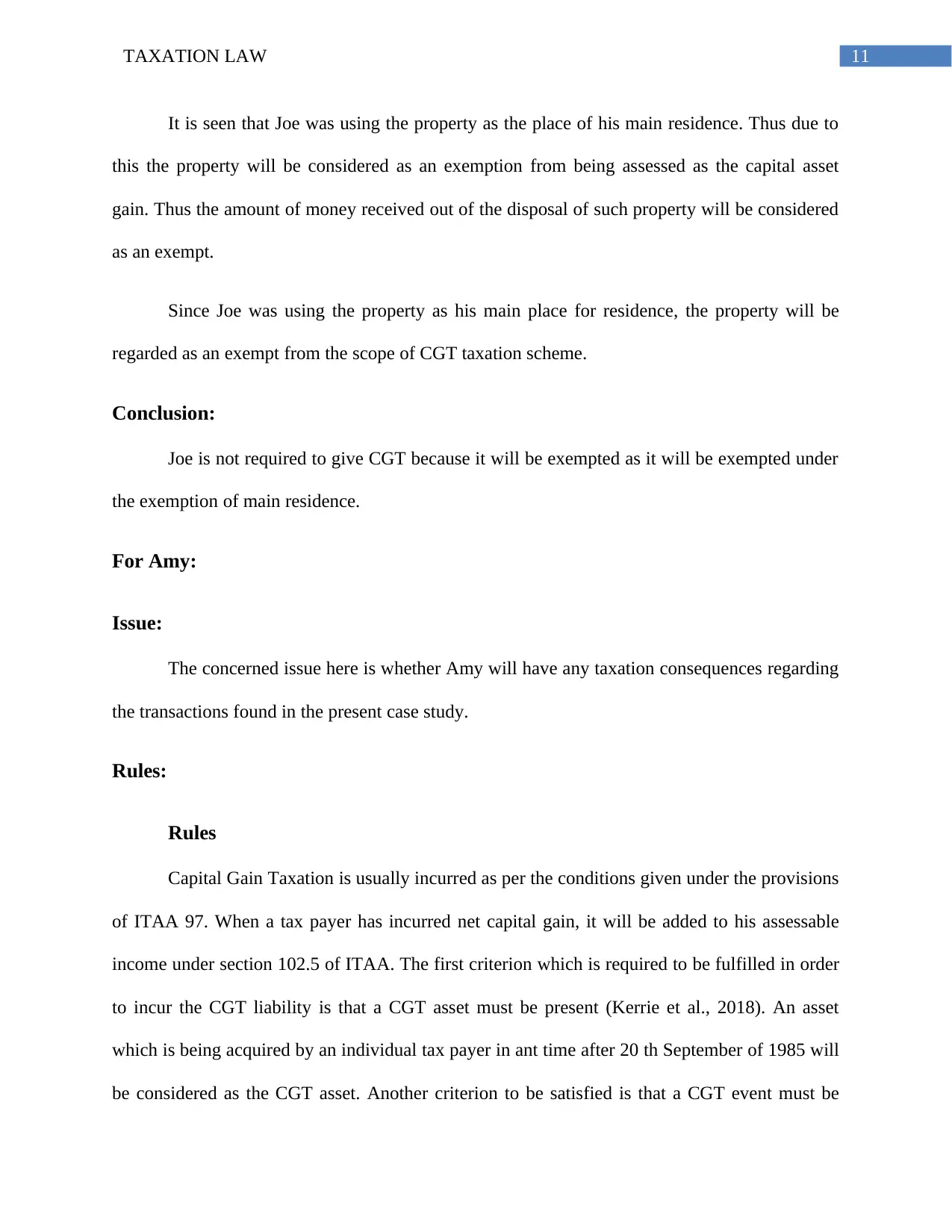
11TAXATION LAW
It is seen that Joe was using the property as the place of his main residence. Thus due to
this the property will be considered as an exemption from being assessed as the capital asset
gain. Thus the amount of money received out of the disposal of such property will be considered
as an exempt.
Since Joe was using the property as his main place for residence, the property will be
regarded as an exempt from the scope of CGT taxation scheme.
Conclusion:
Joe is not required to give CGT because it will be exempted as it will be exempted under
the exemption of main residence.
For Amy:
Issue:
The concerned issue here is whether Amy will have any taxation consequences regarding
the transactions found in the present case study.
Rules:
Rules
Capital Gain Taxation is usually incurred as per the conditions given under the provisions
of ITAA 97. When a tax payer has incurred net capital gain, it will be added to his assessable
income under section 102.5 of ITAA. The first criterion which is required to be fulfilled in order
to incur the CGT liability is that a CGT asset must be present (Kerrie et al., 2018). An asset
which is being acquired by an individual tax payer in ant time after 20 th September of 1985 will
be considered as the CGT asset. Another criterion to be satisfied is that a CGT event must be
It is seen that Joe was using the property as the place of his main residence. Thus due to
this the property will be considered as an exemption from being assessed as the capital asset
gain. Thus the amount of money received out of the disposal of such property will be considered
as an exempt.
Since Joe was using the property as his main place for residence, the property will be
regarded as an exempt from the scope of CGT taxation scheme.
Conclusion:
Joe is not required to give CGT because it will be exempted as it will be exempted under
the exemption of main residence.
For Amy:
Issue:
The concerned issue here is whether Amy will have any taxation consequences regarding
the transactions found in the present case study.
Rules:
Rules
Capital Gain Taxation is usually incurred as per the conditions given under the provisions
of ITAA 97. When a tax payer has incurred net capital gain, it will be added to his assessable
income under section 102.5 of ITAA. The first criterion which is required to be fulfilled in order
to incur the CGT liability is that a CGT asset must be present (Kerrie et al., 2018). An asset
which is being acquired by an individual tax payer in ant time after 20 th September of 1985 will
be considered as the CGT asset. Another criterion to be satisfied is that a CGT event must be
⊘ This is a preview!⊘
Do you want full access?
Subscribe today to unlock all pages.

Trusted by 1+ million students worldwide
1 out of 16
Related Documents
Your All-in-One AI-Powered Toolkit for Academic Success.
+13062052269
info@desklib.com
Available 24*7 on WhatsApp / Email
![[object Object]](/_next/static/media/star-bottom.7253800d.svg)
Unlock your academic potential
Copyright © 2020–2025 A2Z Services. All Rights Reserved. Developed and managed by ZUCOL.




